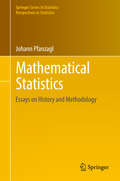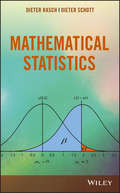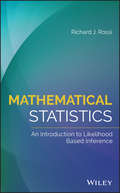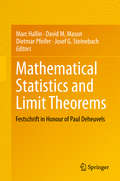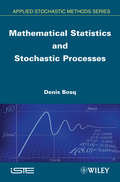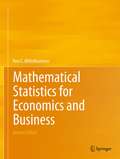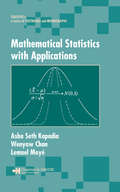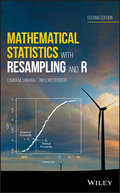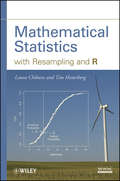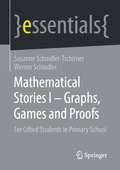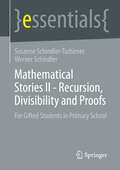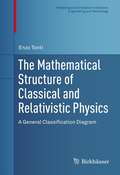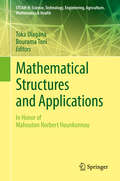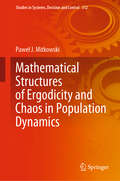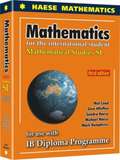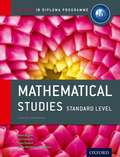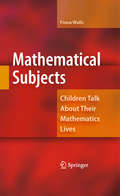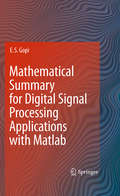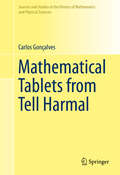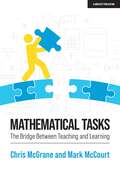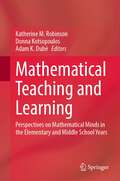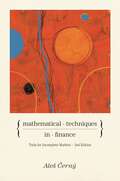- Table View
- List View
Mathematical Statistics
by Johann PfanzaglIn the middle of the last century the development of mathematical statistics underwent an enduring change, due to the use of more refined mathematical tools. New concepts like sufficiency, superefficiency, adaptivity etc. motivated scholars to reflect upon the interpretation of mathematical concepts in terms of their real-world relevance. Questions concerning the optimality of estimators, for instance, had remained unanswered for decades, as a meaningful concept of optimality (based on regularity of the estimators, the representation of their limit distribution and assertions about their concentration by means of Anderson's Theorem) was not yet available. The rapidly developing asymptotic theory provided approximate answers to questions for which non-asymptotic theory had found no satisfying solutions. In four engaging essays, Pfanzagl's book presents a detailed description of how the use of mathematical methods stimulated the development of a statistical theory. A book on the history of mathematical statistics would offer a description of who did what and when. Pfanzagl's book, centred on questions of methodology, points to missed opportunities, questionable proofs, neglected questions of priority, and to the presence of such deficiencies even in recent textbooks.
Mathematical Statistics
by Dieter Rasch Dieter SchottExplores mathematical statistics in its entirety—from the fundamentals to modern methods This book introduces readers to point estimation, confidence intervals, and statistical tests. Based on the general theory of linear models, it provides an in-depth overview of the following: analysis of variance (ANOVA) for models with fixed, random, and mixed effects; regression analysis is also first presented for linear models with fixed, random, and mixed effects before being expanded to nonlinear models; statistical multi-decision problems like statistical selection procedures (Bechhofer and Gupta) and sequential tests; and design of experiments from a mathematical-statistical point of view. Most analysis methods have been supplemented by formulae for minimal sample sizes. The chapters also contain exercises with hints for solutions. Translated from the successful German text, Mathematical Statistics requires knowledge of probability theory (combinatorics, probability distributions, functions and sequences of random variables), which is typically taught in the earlier semesters of scientific and mathematical study courses. It teaches readers all about statistical analysis and covers the design of experiments. The book also describes optimal allocation in the chapters on regression analysis. Additionally, it features a chapter devoted solely to experimental designs. Classroom-tested with exercises included Practice-oriented (taken from day-to-day statistical work of the authors) Includes further studies including design of experiments and sample sizing Presents and uses IBM SPSS Statistics 24 for practical calculations of data Mathematical Statistics is a recommended text for advanced students and practitioners of math, probability, and statistics.
Mathematical Statistics: An Introduction to Likelihood Based Inference
by Richard J. RossiPresents a unified approach to parametric estimation, confidence intervals, hypothesis testing, and statistical modeling, which are uniquely based on the likelihood function This book addresses mathematical statistics for upper-undergraduates and first year graduate students, tying chapters on estimation, confidence intervals, hypothesis testing, and statistical models together to present a unifying focus on the likelihood function. It also emphasizes the important ideas in statistical modeling, such as sufficiency, exponential family distributions, and large sample properties. Mathematical Statistics: An Introduction to Likelihood Based Inference makes advanced topics accessible and understandable and covers many topics in more depth than typical mathematical statistics textbooks. It includes numerous examples, case studies, a large number of exercises ranging from drill and skill to extremely difficult problems, and many of the important theorems of mathematical statistics along with their proofs. In addition to the connected chapters mentioned above, Mathematical Statistics covers likelihood-based estimation, with emphasis on multidimensional parameter spaces and range dependent support. It also includes a chapter on confidence intervals, which contains examples of exact confidence intervals along with the standard large sample confidence intervals based on the MLE's and bootstrap confidence intervals. There’s also a chapter on parametric statistical models featuring sections on non-iid observations, linear regression, logistic regression, Poisson regression, and linear models. Prepares students with the tools needed to be successful in their future work in statistics data science Includes practical case studies including real-life data collected from Yellowstone National Park, the Donner party, and the Titanic voyage Emphasizes the important ideas to statistical modeling, such as sufficiency, exponential family distributions, and large sample properties Includes sections on Bayesian estimation and credible intervals Features examples, problems, and solutions Mathematical Statistics: An Introduction to Likelihood Based Inference is an ideal textbook for upper-undergraduate and graduate courses in probability, mathematical statistics, and/or statistical inference.
Mathematical Statistics and Limit Theorems
by Marc Hallin David M. Mason Dietmar Pfeifer Josef G. SteinebachThis Festschrift in honour of Paul Deheuvels' 65th birthday compiles recent research results in the area between mathematical statistics and probability theory with a special emphasis on limit theorems. The book brings together contributions from invited international experts to provide an up-to-date survey of the field. Written in textbook style, this collection of original material addresses researchers, PhD and advanced Master students with a solid grasp of mathematical statistics and probability theory.
Mathematical Statistics and Stochastic Processes
by Denis BosqGenerally, books on mathematical statistics are restricted to the case of independent identically distributed random variables. In this book however, both this case AND the case of dependent variables, i.e. statistics for discrete and continuous time processes, are studied. This second case is very important for today’s practitioners. Mathematical Statistics and Stochastic Processes is based on decision theory and asymptotic statistics and contains up-to-date information on the relevant topics of theory of probability, estimation, confidence intervals, non-parametric statistics and robustness, second-order processes in discrete and continuous time and diffusion processes, statistics for discrete and continuous time processes, statistical prediction, and complements in probability. This book is aimed at students studying courses on probability with an emphasis on measure theory and for all practitioners who apply and use statistics and probability on a daily basis.
Mathematical Statistics for Economics and Business
by Ron C. MittelhammerMathematical Statistics for Economics and Business, Second Edition, provides a comprehensive introduction to the principles of mathematical statistics which underpin statistical analyses in the fields of economics, business, and econometrics. The selection of topics in this textbook is designed to provide students with a conceptual foundation that will facilitate a substantial understanding of statistical applications in these subjects. This new edition has been updated throughout and now also includes a downloadable Student Answer Manual containing detailed solutions to half of the over 300 end-of-chapter problems. After introducing the concepts of probability, random variables, and probability density functions, the author develops the key concepts of mathematical statistics, most notably: expectation, sampling, asymptotics, and the main families of distributions. The latter half of the book is then devoted to the theories of estimation and hypothesis testing with associated examples and problems that indicate their wide applicability in economics and business. Features of the new edition include: a reorganization of topic flow and presentation to facilitate reading and understanding; inclusion of additional topics of relevance to statistics and econometric applications; a more streamlined and simple-to-understand notation for multiple integration and multiple summation over general sets or vector arguments; updated examples; new end-of-chapter problems; a solution manual for students; a comprehensive answer manual for instructors; and a theorem and definition map. This book has evolved from numerous graduate courses in mathematical statistics and econometrics taught by the author, and will be ideal for students beginning graduate study as well as for advanced undergraduates.
Mathematical Statistics With Applications (Statistics: Textbooks and Monographs #179)
by Asha Seth Kapadia Wenyaw Chan Lemuel A. Moyé<p>Mathematical statistics typically represents one of the most difficult challenges in statistics, particularly for those with more applied, rather than mathematical, interests and backgrounds. Most textbooks on the subject provide little or no review of the advanced calculus topics upon which much of mathematical statistics relies and furthermore contain material that is wholly theoretical, thus presenting even greater challenges to those interested in applying advanced statistics to a specific area. <p>Mathematical Statistics with Applications presents the background concepts and builds the technical sophistication needed to move on to more advanced studies in multivariate analysis, decision theory, stochastic processes, or computational statistics. Applications embedded within theoretical discussions clearly demonstrate the utility of the theory in a useful and relevant field of application and allow readers to avoid sudden exposure to purely theoretical materials.With its clear explanations and more than usual emphasis on applications and computation, this text reaches out to the many students and professionals more interested in the practical use of statistics to enrich their work in areas such as communications, computer science, economics, astronomy, and public health.</p>
Mathematical Statistics with Applications
by Dennis D. Wackerly William Mendenhall III Richard L. ScheafferIn their bestselling title MATHEMATICAL STATISTICS WITH APPLICATIONS, premiere authors Dennis Wackerly, William Mendenhall, and Richard L. Scheaffer present a solid foundation in statistical theory while conveying the relevance and importance of the theory in solving practical problems in the real world. The authors' use of practical applications and excellent exercises helps you discover the nature of statistics and understand its essential role in scientific research. With the addition of contributor Brendan Ames, MATHEMATICAL STATISTICS WITH APPLICATIONS now includes an enhanced eTextbook. Simulation activities using interactive applets and R embedded within the MindTap Reader help students visualize statistical concepts, and an appendix introducing students to statistical data analysis using R can be found at the end of the eTextbook.
Mathematical Statistics with Resampling and R: With Applications And R Set
by Laura M. Chihara Tim C. HesterbergThis thoroughly updated second edition combines the latest software applications with the benefits of modern resampling techniques Resampling helps students understand the meaning of sampling distributions, sampling variability, P-values, hypothesis tests, and confidence intervals. The second edition of Mathematical Statistics with Resampling and R combines modern resampling techniques and mathematical statistics. This book has been classroom-tested to ensure an accessible presentation, uses the powerful and flexible computer language R for data analysis and explores the benefits of modern resampling techniques. This book offers an introduction to permutation tests and bootstrap methods that can serve to motivate classical inference methods. The book strikes a balance between theory, computing, and applications, and the new edition explores additional topics including consulting, paired t test, ANOVA and Google Interview Questions. Throughout the book, new and updated case studies are included representing a diverse range of subjects such as flight delays, birth weights of babies, and telephone company repair times. These illustrate the relevance of the real-world applications of the material. This new edition: • Puts the focus on statistical consulting that emphasizes giving a client an understanding of data and goes beyond typical expectations • Presents new material on topics such as the paired t test, Fisher's Exact Test and the EM algorithm • Offers a new section on "Google Interview Questions" that illustrates statistical thinking • Provides a new chapter on ANOVA • Contains more exercises and updated case studies, data sets, and R code Written for undergraduate students in a mathematical statistics course as well as practitioners and researchers, the second edition of Mathematical Statistics with Resampling and R presents a revised and updated guide for applying the most current resampling techniques to mathematical statistics.
Mathematical Statistics with Resampling and R
by Laura M. Chihara Tim C. HesterbergThis book bridges the latest software applications with the benefits of modern resampling techniquesResampling helps students understand the meaning of sampling distributions, sampling variability, P-values, hypothesis tests, and confidence intervals. This groundbreaking book shows how to apply modern resampling techniques to mathematical statistics. Extensively class-tested to ensure an accessible presentation, Mathematical Statistics with Resampling and R utilizes the powerful and flexible computer language R to underscore the significance and benefits of modern resampling techniques.The book begins by introducing permutation tests and bootstrap methods, motivating classical inference methods. Striking a balance between theory, computing, and applications, the authors explore additional topics such as:Exploratory data analysisCalculation of sampling distributionsThe Central Limit TheoremMonte Carlo samplingMaximum likelihood estimation and properties of estimatorsConfidence intervals and hypothesis testsRegressionBayesian methodsThroughout the book, case studies on diverse subjects such as flight delays, birth weights of babies, and telephone company repair times illustrate the relevance of the real-world applications of the discussed material. Key definitions and theorems of important probability distributions are collected at the end of the book, and a related website is also available, featuring additional material including data sets, R scripts, and helpful teaching hints.Mathematical Statistics with Resampling and R is an excellent book for courses on mathematical statistics at the upper-undergraduate and graduate levels. It also serves as a valuable reference for applied statisticians working in the areas of business, economics, biostatistics, and public health who utilize resampling methods in their everyday work.
Mathematical Stories I – Graphs, Games and Proofs: For Gifted Students in Primary School (essentials)
by Susanne Schindler-Tschirner Werner SchindlerWith the help of tried and tested, carefully elaborated learning units, the authors convey fundamental mathematical techniques in this essential, which are important far beyond primary school. In the present volume I, path problems and word puzzles are modeled and solved using undirected and directed graphs. Simple math games are systematically analyzed and the optimal strategies are determined. Students learn to gradually reduce difficult problems to simpler ones and to provide evidence in different contexts. The tasks encourage mathematical thinking, imagination and creativity. The detailed sample solutions are designed for non-mathematicians. This book is a translation of the original German 1st edition Mathematische Geschichten I – Graphen, Spiele und Beweise by Susanne Schindler-Tschirner and Werner Schindler, published by Springer Fachmedien Wiesbaden GmbH, part of Springer Nature in 2019. The translation was done with the help of artificial intelligence (machine translation by the service DeepL.com). A subsequent human revision was done primarily in terms of content, so that the book will read stylistically differently from a conventional translation. Springer Nature works continuously to further the development of tools for the production of books and on the related technologies to support the authors.
Mathematical Stories II - Recursion, Divisibility and Proofs: For Gifted Students in Primary School (essentials)
by Susanne Schindler-Tschirner Werner SchindlerUsing field-tested, carefully crafted units of study, the authors in this essential teach fundamental mathematical techniques that are relevant well beyond the elementary school years. In this Volume II, the Gaussian summation formula and a recursion formula are derived and applied. Tasks on divisibility, prime factors and divisors follow. For calculating with remainders, the modulo calculation is introduced and applied. Students learn to perform proofs in a variety of contexts. As in Volume I, "Graphs, Games, and Proofs," the tasks encourage mathematical thinking skills, imagination, and creativity. The detailed sample solutions are designed for non-mathematicians.This book is a translation of the original German 1st edition Mathematische Geschichten II – Rekursion, Teilbarkeit und Beweise by Susanne Schindler-Tschirner and Werner Schindler, published by Springer Fachmedien Wiesbaden GmbH, part of Springer Nature in 2019. The translation was done with the help of artificial intelligence (machine translation by the service DeepL.com). A subsequent human revision was done primarily in terms of content, so that the book will read stylistically differently from a conventional translation. Springer Nature works continuously to further the development of tools for the production of books and on the related technologies to support the authors.
The Mathematical Structure of Classical and Relativistic Physics: A General Classification Diagram
by Enzo TontiThe theories describing seemingly unrelated areas of physics have surprising analogies that have aroused the curiosity of scientists and motivated efforts to identify reasons for their existence. Comparative study of physical theories has revealed the presence of a common topological and geometric structure. The Mathematical Structure of Classical and Relativistic Physics is the first book to analyze this structure in depth, thereby exposing the relationship between (a) global physical variables and (b) space and time elements such as points, lines, surfaces, instants, and intervals. Combining this relationship with the inner and outer orientation of space and time allows one to construct a classification diagram for variables, equations, and other theoretical characteristics. The book is divided into three parts. The first introduces the framework for the above-mentioned classification, methodically developing a geometric and topological formulation applicable to all physical laws and properties; the second applies this formulation to a detailed study of particle dynamics, electromagnetism, deformable solids, fluid dynamics, heat conduction, and gravitation. The third part further analyses the general structure of the classification diagram for variables and equations of physical theories. Suitable for a diverse audience of physicists, engineers, and mathematicians, The Mathematical Structure of Classical and Relativistic Physics offers a valuable resource for studying the physical world. Written at a level accessible to graduate and advanced undergraduate students in mathematical physics, the book can be used as a research monograph across various areas of physics, engineering and mathematics, and as a supplemental text for a broad range of upper-level scientific coursework.
Mathematical Structures and Applications: In Honor Of Mahouton Norbert Hounkonnou (STEAM-H: Science, Technology, Engineering, Agriculture, Mathematics & Health)
by Toka Diagana Bourama ToniThis contributed volume features invited papers on current research and applications in mathematical structures. Featuring various disciplines in the mathematical sciences and physics, articles in this volume discuss fundamental scientific and mathematical concepts as well as their applications to topical problems. Special emphasis is placed on important methods, research directions and applications of analysis within and beyond each field. Covered topics include Metric operators and generalized hermiticity, Semi-frames, Hilbert-Schmidt operator, Symplectic affine action, Fractional Brownian motion, Walker Osserman metric, Nonlinear Maxwell equations, The Yukawa model, Heisenberg observables, Nonholonomic systems, neural networks, Seiberg-Witten invariants, photon-added coherent state, electrostatic double layers, and star products and functions. All contributions are from the participants of the conference held October 2016 in Cotonou, Benin in honor of Professor Mahouton Norbert Hounkonnou for his outstanding contributions to the mathematical and physical sciences and education. Accessible to graduate students and postdoctoral researchers, this volume is a useful resource to applied scientists, applied and pure mathematicians, and mathematical and theoretical physicists.
Mathematical Structures of Ergodicity and Chaos in Population Dynamics (Studies in Systems, Decision and Control #312)
by Paweł J. MitkowskiThis book concerns issues related to biomathematics, medicine, or cybernetics as practiced by engineers. Considered population dynamics models are still in the interest of researchers, and even this interest is increasing, especially now in the time of SARS-CoV-2 coronavirus pandemic, when models are intensively studied in order to help predict its behaviour within human population. The structures of population dynamics models and practical methods of finding their solutions are discussed. Finally, the hypothesis of the existence of non-trivial ergodic properties of the model of erythropoietic response dynamics formulated by A. Lasota in the form of delay differential equation with unimodal feedback is analysed. The research can be compared with actual medical data, as well as shows that the structures of population models can reflect the dynamic structures of reality.
Mathematical Studies
by Mal Coad Glen Whiffen Sandra Haese Michael Haese Mark HumphriesMathematics for the International Student: Mathematical Studies SL has been written to embrace the syllabus for the two-year Mathematical Studies SL Course, to be first examined in 2014.
Mathematical studies Standard Level: Course Companion (Oxford IB Diploma Programme)
by Peter Blythe Jim Fensom Jane Forrest Paula Waldman de TokmanNumber and algebra 1, Descriptive statistics, Geometry and trigonometry 1, Mathematical models, Statistical applications, Introducing differential calculus, Number and algebra 2, Sets and probability, Logic, Geometry and trigonometry 2, Project, Getting the most out of your GDC, Prior learning.
Mathematical Subjects
by Fiona WallsWe know the process by which children become social, moral, and creative beings, but when--and how--do they become mathematical beings? This thought-provoking volume follows ten children (ages seven through eighteen) in schools in New Zealand, England, Australia, Sweden, and an international school in Switzerland as they come to recognize the mathematical as part of their lives, their academic identities, and their identities as human beings. Through these students' experiences important themes emerge, including mathematics as work, a domain of learning, and an avenue for competition; mathematical ability as a key to how they are perceived by others; and the relationships between mathematics achievement and the larger social and academic picture. This comparative study of educational systems and academic development will inform readers in these and other salient areas: Theoretical bases for understanding children as mathematical subjects. Help in creating the mathematical self: tutoring and related programs. The roles of compulsory study and standardized assessment. Class and ethnic content in children's math narratives. The gendering of mathematical ability and activity. What children's math experience can teach us about teaching the subject. Children Talk about Their Mathematics Lives opens bold windows onto how young people learn and how disparities arise, making it a cutting-edge resource for researchers and libraries, graduates and teachers in mathematics education and early childhood education.
Mathematical Summary for Digital Signal Processing Applications with Matlab
by E. S. GopiMathematical summary for Digital Signal Processing Applications with Matlab consists of Mathematics which is not usually dealt in the DSP core subject, but used in DSP applications. Matlab programs with illustrations are given for the selective topics such as generation of Multivariate Gaussian distributed sample outcomes, Bacterial foraging algorithm, Newton's iteration, Steepest descent algorithm, etc. are given exclusively in the separate chapter. Also Mathematical summary for Digital Signal Processing Applications with Matlab is written in such a way that it is suitable for Non-Mathematical readers and is very much suitable for the beginners who are doing research in Digital Signal Processing.
Mathematical Tablets from Tell Harmal
by Carlos GonçalvesThis work offers a re-edition of twelve mathematical tablets from the site of Tell Harmal, in the borders of present-day Baghdad. In ancient times, Tell Harmal was Saduppûm, a city representative of the region of the Diyala river and of the kingdom of Esnunna, to which it belonged for a time. These twelve tablets were originally published in separate articles in the beginning of the 1950s and mostly contain solved problem texts. Some of the problems deal with abstract matters such as triangles and rectangles with no reference to daily life, while others are stated in explicitly empirical contexts, such as the transportation of a load of bricks, the size of a vessel, the number of men needed to build a wall and the acquisition of oil and lard. This new edition of the texts is the first to group them, and takes into account all the recent developments of the research in the history of Mesopotamian mathematics. Its introductory chapters are directed to readers interested in an overview of the mathematical contents of these tablets and the language issues involved in their interpretation, while a chapter of synthesis discusses the ways history of mathematics has typically dealt with the mathematical evidence and inquires how and to what degree mathematical tablets can be made part of a picture of the larger social context. Furthermore, the volume contributes to a geography of the Old Babylonian mathematical practices, by evidencing that scribes at Saduppûm made use of cultural material that was locally available. The edited texts are accompanied by translations, philological, and mathematical commentaries.
A Mathematical Tapestry
by Peter Hilton Jean Pedersen Sylvie DonmoyerThis easy-to-read 2010 book demonstrates how a simple geometric idea reveals fascinating connections and results in number theory, the mathematics of polyhedra, combinatorial geometry, and group theory. Using a systematic paper-folding procedure it is possible to construct a regular polygon with any number of sides. This remarkable algorithm has led to interesting proofs of certain results in number theory, has been used to answer combinatorial questions involving partitions of space, and has enabled the authors to obtain the formula for the volume of a regular tetrahedron in around three steps, using nothing more complicated than basic arithmetic and the most elementary plane geometry. All of these ideas, and more, reveal the beauty of mathematics and the interconnectedness of its various branches. Detailed instructions, including clear illustrations, enable the reader to gain hands-on experience constructing these models and to discover for themselves the patterns and relationships they unearth.
Mathematical Tasks: The Bridge Between Teaching and Learning
by Chris McGrane Mark McCourtIf we want our pupils to develop fluency, understanding and the ability to solve complex problems, then it is vital that teachers develop the ability to select, adapt and design appropriate mathematical tasks. In 'Mathematical Tasks: The Bridge Between Teaching and Learning', Chris McGrane and Mark McCourt a range of practical approaches, strategies and principles behind the design and effective use of tasks in the mathematics classroom that lead to all pupils becoming successful learners. First-hand interviews with world class mathematics education experts and practicing teachers bring to life the ideas behind how tasks can act as a bridge between what the teacher wants the pupil to make sense of and what the pupil actually does makes sense of; tasks are how we enable pupils to enact mathematics - it is only by being mathematical that pupils can truly make connections across mathematical ideas and understand the bigger picture. This is a book for classroom teachers. Chris McGrane offers a range of practical examples for nurturing deep learning in mathematics that can be adapted and embedded in one's own classroom practice. This is also a book for those who are interested in the theory behind tasks. Chris and his interviewees examine the key role tasks play in shaping learning, teaching, curriculum and assessment. Suitable for teachers at all stages in their careers and teachers are encouraged to return to the book from time to time over the years to notice how their use of tasks in the classroom changes as they themselves develop.
Mathematical Tasks: The Bridge Between Teaching and Learning
by Chris McGrane Mark McCourtIf we want our pupils to develop fluency, understanding and the ability to solve complex problems, then it is vital that teachers develop the ability to select, adapt and design appropriate mathematical tasks. In 'Mathematical Tasks: The Bridge Between Teaching and Learning', Chris McGrane and Mark McCourt a range of practical approaches, strategies and principles behind the design and effective use of tasks in the mathematics classroom that lead to all pupils becoming successful learners. First-hand interviews with world class mathematics education experts and practicing teachers bring to life the ideas behind how tasks can act as a bridge between what the teacher wants the pupil to make sense of and what the pupil actually does makes sense of; tasks are how we enable pupils to enact mathematics - it is only by being mathematical that pupils can truly make connections across mathematical ideas and understand the bigger picture. This is a book for classroom teachers. Chris McGrane offers a range of practical examples for nurturing deep learning in mathematics that can be adapted and embedded in one's own classroom practice. This is also a book for those who are interested in the theory behind tasks. Chris and his interviewees examine the key role tasks play in shaping learning, teaching, curriculum and assessment. Suitable for teachers at all stages in their careers and teachers are encouraged to return to the book from time to time over the years to notice how their use of tasks in the classroom changes as they themselves develop.
Mathematical Teaching and Learning: Perspectives on Mathematical Minds in the Elementary and Middle School Years
by Katherine M. Robinson Donna Kotsopoulos Adam K. DubéThis book focusses on teaching and learning in elementary and middle school mathematics and suggests practices for teachers to help children be successful mathematical thinkers. Contributions from diverse theoretical and disciplinary perspectives are explored. Topics include the roles of technology, language, and classroom discussion in mathematics learning, the use of creativity, visuals, and teachers’ physical gestures to enhance problem solving, inclusive educational activities to promote children’s mathematics understanding, how learning in the home can enhance children’s mathematical skills, the application of mathematics learning theories in designing effective teaching tools, and a discussion of how students, teachers, teacher educators, and school boards differentially approach elementary and middle school mathematics. This book and its companion, Mathematical Cognition and Understanding, take an interdisciplinary perspective to mathematical learning and development in the elementary and middle school years. The authors and perspectives in this book draw from education, neuroscience, developmental psychology, and cognitive psychology. The book will be relevant to scholars/educators in the field of mathematics education and also those in childhood development and cognition. Each chapter also includes practical tips and implications for parents as well as for educators and researchers.
Mathematical Techniques in Finance: Tools for Incomplete Markets - Second Edition
by Ales CernýOriginally published in 2003, Mathematical Techniques in Finance has become a standard textbook for master's-level finance courses containing a significant quantitative element while also being suitable for finance PhD students. This fully revised second edition continues to offer a carefully crafted blend of numerical applications and theoretical grounding in economics, finance, and mathematics, and provides plenty of opportunities for students to practice applied mathematics and cutting-edge finance. Ales Cerný mixes tools from calculus, linear algebra, probability theory, numerical mathematics, and programming to analyze in an accessible way some of the most intriguing problems in financial economics. The textbook is the perfect hands-on introduction to asset pricing, optimal portfolio selection, risk measurement, and investment evaluation. The new edition includes the most recent research in the area of incomplete markets and unhedgeable risks, adds a chapter on finite difference methods, and thoroughly updates all bibliographic references. Eighty figures, over seventy examples, twenty-five simple ready-to-run computer programs, and several spreadsheets enhance the learning experience. All computer codes have been rewritten using MATLAB and online supplementary materials have been completely updated. A standard textbook for graduate finance courses Introduction to asset pricing, portfolio selection, risk measurement, and investment evaluation Detailed examples and MATLAB codes integrated throughout the text Exercises and summaries of main points conclude each chapter
